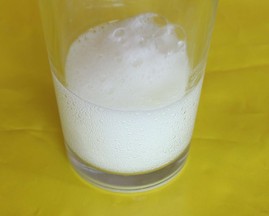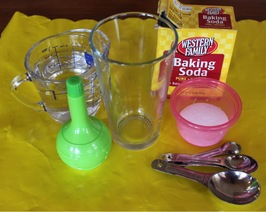Evan and Jessie make plenty of lemonade in The Lemonade War. Let’s make some of our own and see if we can learn some chemistry at the same time!
Here’s what you’ll need:
- Lemon juice (either from a bottle or from a real lemon)
- Baking soda
- Water
- Sugar
- drinking glass
- spoon
First, pour 1/4 cup lemon juice (or all the juice you can squeeze out of your lemon) into the glass. Make note of how the lemon juice smells and looks and tastes all by itself. (As you’ll notice in my picture, lime juice works equally well.) Add a tablespoon of water to the glass. Then add a pinch of baking soda to the glass. Check out all those bubbles! (You can try adding up to a tablespoon in another glass to watch more bubbles form, but it might not be edible afterward.)

So what’s happening? The citric acid in the lemon juice is reacting with the baking soda (sodium bicarbonate) to make the same bubbles you see in soda–carbon dioxide (plus some more water molecules.) Add the rest of your cup of water and stir it up.
What does it taste like now? Take a very, very small taste. What’s missing? We have our lemon juice, water, and even some bubbles. So why does it taste so terrible? We’re missing sugar (sucrose)! Add 1/4 cup sugar to your lemonade and stir until the sugar dissolves.
When a solid dissolves, its particles break up and spread themselves all through a liquid. But even though the sugar is disappearing, it’s definitely still in there! Taste your lemonade for proof. 🙂
By the way, you can have more chemistry fun by checking out these tasty chemical reactions or by building all of the molecules linked above using this gumdrop molecule activity.
